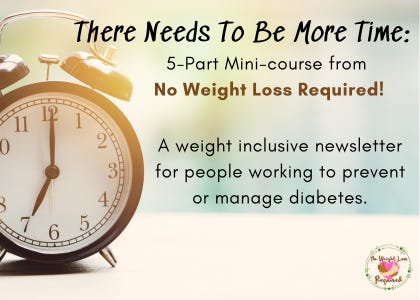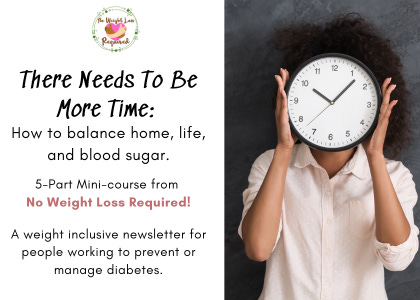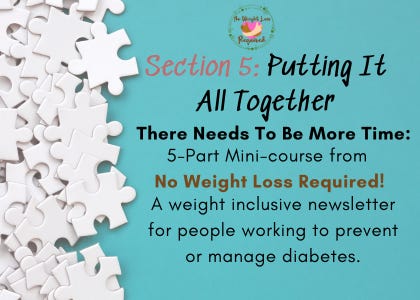There Needs to Be More Time
This 5-part mini-course is designed to help you transform your relationship with time.
We often feel like there isn't enough time. This feeling becomes a fear, reinforcing the cycle of time scarcity. You want to find a way to break out of this cycle, to see time differently. Having this would give you a whole new view of time.
Hello, and welcome. I wrote this course to help my clients find time to prevent or manage diabetes. No, this isn't a new hack or an exercise in time management. It is a new way to visualize time and see how time, food, eating, and diet culture combine in many surprising ways.
About this course: It is divided into five sections. Each section offers a video that enhances the included ebook.
Let's take a look at each section in more detail.
In Section 1, you'll explore how a poverty mindset affects your perception of time and how you can shift toward a more abundant perspective. Each section provides hands-on activities for you to visualize time by the mental energy a task takes.
In Section 2, time blocks. Instead of getting lost in the details of seconds, minutes, and hours, you'll learn to visualize your day in manageable blocks. This approach reduces overwhelm and allows you to prioritize tasks and activities more clearly. Begin to create your own time blocks by completing the practice activities in this section.
Section 3 introduces the four types of time: creative, productive, maintenance, and transition. Understanding these distinct categories helps you manage time more effectively, ensuring that your life is balanced, not urgent. Three amazing activities deepens your insight and clarifies how you can use this new view of time.
Next, in Section 4, I'll explore how food, meals, and transition times are key time markers in our daily lives. You'll gain insight into how these elements can serve as anchors, helping you remember tasks to fill your day with ease and balance.
Finally, in Section 5, you'll put everything into practice by scheduling your ideal day using your newfound knowledge about the four types of time. This last section brings together all of your learning; from seeing time in abundance to time blocks and transition time, you'll practice crafting a balanced, fulfilling life that includes time for you to prevent or manage diabetes.
At the end of each section, practice using the Discover, Explore, Play, and Challenge process to start seeing time differently. Ideas and activities about how you can apply these concepts to your life are included.
Section 1
Time Blocks - Section 2
In Section 1, you learned how poverty mind can change how you see and value time. You took time to explore how diet culture can amplify poverty mind thoughts in ways that devalue self-care. You also learned that letting go of poverty mind is a necessary step to self-care.
Section 3: Four Types of Time
You have already learned a lot in sections one and two. We've talked about identifying a poverty mindset, which is a lack of self-compassion. You have started to piece together the many ways weight stigma can interrupt your sense of belonging. Weight stigma makes it easy to devalue self-care, and let's be honest, you don't make time for things you don't value. You also got to see five-time blocks. You understand the block begins and ends with a transition activity each time. You explored how not to get lost in the details of seconds, minutes, and hours. Doing this can overcomplicate your day. Time blocks reduce being overwhelmed. They help you identify when your tasks and activities can be completed. In this section, you will explore how time has different qualities.
Section 4: The Perfect Day
It is good to review what you have already learned. In Section 3, you realized that it isn't about the amount of time you have but the quality of your time that matters. Specifically, that time has different attributes; some are creative, some are productive, maintenance, and the time it takes to transition between tasks. It is easy to get distracted by the sense of urgency; time is finite, and there is a sequence within each day. However, the goal of this program is to recenter your intention on balance, not urgency, or 'getting more done." You also explored how having unseen time can lead to binge thinking - the idea that if you work hard, you can relax. Binge thinking leads to binge eating. To reduce the likelihood of binge eating, you need to see that you get to relax. Not everything is urgent, and you don't have to have a perfect life, day, or outcome to relax. The desire to be perfect, to get everything done, is impossible, but even with this truth, it is hard to let go of this deeper desire. Having a balanced life creates the feeling of ease that is the foundation for sustainable self-care.
Section Five: Putting It All Together
You have learned about poverty mind, and how diet culture can amplify the feelings of not having or being enough. You also learned more about weight and diabetes stigma. In section 2, you learned about time blocks and how these chunks have a transition on each end. You must play with your calendar to identify when your time blocks start and stop. In section 3, you explored the four times of time and learned why it is easy to get overscheduled and fall victim to binge thinking, which can lead to binge eating. In this section, you will see examples of the different types of time. In section four, you planned your perfect day, which is a day when you feel a deep sense of balance. In this final section, you will put your learning together. We will create time blocks and review how these can help you schedule your day in a way that supports sustainable self-care.








